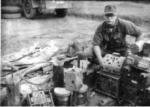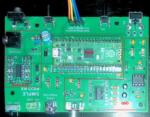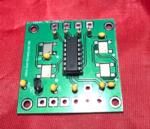
Posted By: Robert Nickels (ranickels) Posted: 02/18/2022 Historic 02/18/2022 |
The William L. Howard Museuman unrivalled collection... |
|||||
|
LTC William L. Howard amassed a collection and in fact realized his dream of creating a museum that showcased the Army's technical intelligence operations - and a lot more. The following excerpt was written by Col. Howard and Todd KA1KAQ:
I left active duty in Feb 1970 and worked for Sun Oil company and then Liberty Mutual Insurance company and was active in the Army Reserve with a Manoeuvre Training Command, running field training exercises for Army Reserve and National Guard units in a four state area. During this period I put together a large collection of foreign weapons and material. I sold the collection to the Hershburger Brothers of Indiana. Walt Hershberger later became the first Foreign Material Training Officer with the newly re-created technical intelligence unit at Aberdeen Proving Ground. In 1976, I returned to college at the University of South Florida and got a second undergraduate degree in Engineering. Graduated in 1979 as the Soviets were invading Afghanistan. I went to work for Battelle Memorial Institute in Columbus, Ohio. I was a researcher in the Ordnance Technology Division where we did many classified studies on Soviet bloc weapon systems and other topics. I left Battelle in 1981 due to a personnel cutback and went to work as the Special Assistant to the President of Leatherwood Industries in Stephenville, Texas. We made the ART II sniper scope and also held the patents on the MAC 10 submachine guns. I left there in 1983 and was still active in the US Army Reserve. I had transferred to Armour Branch and was now a Mobilisation Designee to the Defence Intelligence Agency. During my summer tours there I wrote the national intelligence collection requirements for Cuba, Indo China and for Soviet Science and Technology. When I finished those tours, ill health in members of my family forced me to spend the next few years caring for them which was a full time job. Once they had passed away, I moved back to Florida and officially retired from the Army Reserve. I began collecting again and started building radios. My ambition had been to eventually establish a museum to preserve the history of the Army's technical intelligence operations. To this end I again started collecting weapons, radios, books, and documents that relate to the subject. My mother passed away in 1994 and I now have a large home in the Tampa Bay area which houses the collection. The garage, office and workshop area are filled with WW II, one bedroom is Korean War era, another bedroom is the Vietnam war era and a large "Florida Room" is the current period, 1970 to now. I have one of the larger collections of Japanese radios and communication equipment in the nation. It increases in size each year as items become available. I have produced a more comprehensive book on Japanese communication with many colour pictures. It has been up-dated several times. I have remained active in technical intelligence as a retiree. I was an invited guest to the building dedication ceremony of the new eight and a half million dollar foreign material intelligence complex in 1988. Since then, I have been brought to Aberdeen Proving Ground on several occasions to teach the introduction to technical intelligence phase of the technical intelligence analysis course taught there twice a year. In 1996 I was nominated for the Military Intelligence Hall of Fame. In 1997, I was a distinguished guest at the Change of Command Ceremony. LTC William L. Howard Deceased Bill was not a radio ham or a big electronics hobbyist. But he did have a strong drive to create perfectly complete museum-like displays of WW2 radio equipment, mainly German and Japanese equipment. Some of his articles will live on for a long time, on Army Radio Sales website. His effort was one of the first and still is one of very few efforts to systematically catalogue communications equipment of WW2 and the Vietnam war. Some background from health of William L. Howard Bill served in Viet Nam, collecting and evaluation equipment from the battlefield for intelligence purposes. One of the most interesting pieces in his museum was a Chinese-made VC or NVA radio with 20+ bullet holes in it. He also had a large collection of weapons, about all that needs to be said on the topic. Spy/Covert gear, maps, documentation - you name it, chances are he had one in the collection. CLICK HERE TO VEW PHOTOS OF THE COLLECTION TAKEN BY BRIAN KN4R IN 2004 |
||||||
Latest Articles

Technical
Posted: 01/29/2025
Comments: 0 |
Pico Rx performance - Excellent performance on 630m WSPR
The Simple Pico Rx is my minimalist implementation of Jonathan Dawson's "Pico Rx" at 101things: https://github.com/dawsonjon/PicoRX In this basic form the receiver consists of a Quadrature Sampling Detector (QSD aka Tayloe) and the Pico2 MCU which handles all DSP functions. There are NO front-end filters, the only bandwidth limitation comes from the tracking filter... READ MORE |

Crystal Replacement
Posted: 08/226/2024
Comments: 0 |
Making SMT "no lead" parts easier to use
SMT is the future - but how can we actually use parts without leads? ... READ MORE |
|
Crystal Replacement
Posted: 02/38/2024
Comments: 0 |
How good can a crummy receiver be?
Hundreds of different simple SDR receivers have been designed around Dan Tayloe's Quadrature Sampling Detector or QSD. Mine add nothing to the state of the art, and in fact subtract things, as I like minimalist solutions and the QSD is right in that sweet spot. Following the evolution of Tayloe's design I delete the resistors in series with the sample lines for inst... READ MORE |

Technical
Posted: 02/37/2024
Comments: 0 |
What's in a number (3253)?
The FST3253 dual four-to-one mux/demux IC has long been used as a "Tayloe Detector" or QSD (and QSE) in low-cost SDRs. They provide incredible performance for such a simple circuit, converting RF to baseband IQ with low loss and the ultimate in simplicity. Unfortunately the original FST3253 part has become obsolete and while substitutes are available, this is where the... READ MORE |

Vintage Ham Radio
Posted: 02/32/2024
Comments: 0 |
The Stancor 10P Transmitter
There weren't really many commercial transmitters in the 1930s as most hams built their own. But many of the ones that were offered came from the transformer companies who had two chances to profit. First, from those who would buy the kit, and two, from those would would see it in the (free) booklets the companies provided to their distributors who would then sell the iron to ham... READ MORE |

Vintage Ham Radio
Posted: 12/355/2023
Comments: 0 |
The Care and Feeding of the EF Johnson Courier amplifier
The EF Johnson "Courier" is a grid-driven amplifier using two 811A tubes. Switching is provided for operating in either class C for CW or as a class B linear amplifier for AM or SSB. Rated power is 500 watts input for CW, 500 watts PEP input for SSB, and 200 watts input for double-sideband AM with carrier. Since all amateur power levels were meas... READ MORE |

Historic
Posted: 11/329/2023
Comments: 0 |
TV Duplexer
Some things are interesting, even if totally useless nowadays. Such is the case with the Philco 426-3034 Crossover Kit for UHF TV. What the heck is that? Well, back in the late 50s, UHF television stations operating on channels 14-83 started to appear in many areas of the US where viewers had a VHF-only TV antenna, and in many cases an externa UHF converter was... READ MORE |

Crystal Replacement
Posted: 11/327/2023
Comments: 0 |
Replacing failed crystals
For decades, quartz crystals were used everywhere a stable frequency source was needed, even in some applications that depended on overtone (harmonic) behavior into the VHF range. These crystals were less stable and more dependent on circuit parameters that fundamental types and thus more problematic. Such was the case with the 94 MHz crystal in the 2 meter converter ... READ MORE |

Historic
Posted: 11/315/2023
Comments: 0 |
My Own Ham Radio Story by W9RAN
Everyone has a story of how they got involved in ham radio - this is mine. It started much earlier, including receiving a Knight Kit Span Master shortwave radio for Christmas in about 1963, at age 12. I'll never forget the night my dad and I finished building it and I wanted to try it out. It came with a 50 ft. antenna which was still coiled up - but ... READ MORE |

Technical
Posted: 09/267/2023
Comments: 0 |
Hot to simulate vacuum tubes in LTSpice
LTSice is a powerful simulation tool that is provided free by Linear Technology Corp. It comes with a complete library of passive and common analog solid-state components but if you want to use it to simulate vacuum tubes, it doesen't work as-is. Even though triode and pentode symbols can be found in the "Misc" folder, they are just schematic symbols and... READ MORE |

